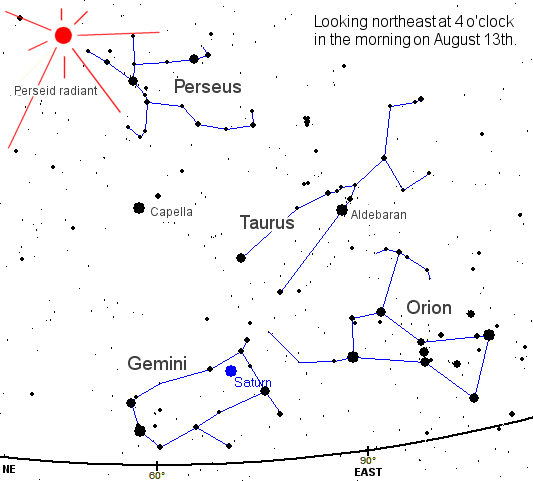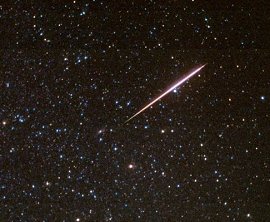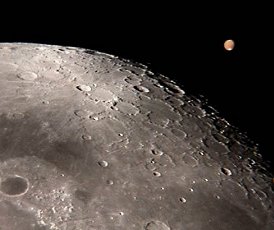 |
Home |
File a UFO Report |
View UFO Reports |
|
![]()
The 2003 Perseid Meteor Shower
August 12th & 13th 2003
SOURCE: science.nasa.gov
Right: A Perseid fireball photographed in 1997 by Rick Scott and Joe Orman.
When skies are dark and clear, observers often see as many as one hundred Perseids per hour--an impressive display. This year, however, skies won't be dark. A glaring full moon will wipe out many faint meteors and reduce by a factor of two or three the number you can see.
Even so, it's worth planning a trip to the country or rearranging your camping schedule to be outdoors when the Perseids arrive.
"No matter where you live, the best time to look will be just before dawn on Wednesday morning, August 13th," says Bill Cooke of NASA's Space Environments Team at the Marshall Space Flight Center. At that time, the sky overhead will be tilted into the debris stream of Comet Swift-Tuttle--the source of the Perseid meteors. Furthermore, the moon will be low in the sky before dawn. You can stand in the shadow of a building or a hill or some other Moon-baffle to reduce its glare.
Last year in November Cooke led a team of astronomers to study the Leonid meteor storm, which likewise happened during a full moon. "Observers who ducked into the shadows counted twice as many meteors as those who stood in full moonlight."
Another way to minimize the bad effects of the moon is to travel to a site where the air is clear.
Even when you face away from the Moon, Cooke explains, the air glows because of moonlight scattered from air molecules and aerosols (e.g., water droplets, dust and pollution). This glow will be less in places where the air is dry and pollution-free. Mountaintops are excellent because they rise above the humid lower atmosphere and most aerosols.
Once you find your observing site and settle in--a comfortable chair and blankets are recommended--there's no special direction you have to face. Perseids can appear anywhere in the sky.
When you see a Perseid, perhaps even one streaking past Mars, trace its tail backward. It will lead to the constellation Perseus.
"Perseid meteors stream out of a point in Perseus called the radiant," he explains. Because of foreshortening, meteors near the radiant appear short and stubby. Meteors away from the radiant are longer and more eye-catching.
Speaking of long meteors... You can see some really long ones on Tuesday evening, August 12th. They're called Earthgrazers. Earthgrazers are shooting stars that emerge from the horizon and streak horizontally through the atmosphere. They tend to be slow, bright and colorful.
Below: The northeastern sky at 4 o'clock in the morning on August 13, 2003. Meteors will seem to flow from a point in Perseus called "the radiant" (red dot). Don't forget to look for Saturn in Gemini.

Between 8 p.m. and 9:30 p.m. on August 12th is a good time to look for Perseid Earthgrazers because," explains Cooke, "the constellation Perseus will be hanging low near the northeastern horizon--a good geometry for grazing meteors."
The Moon will be hanging low then, too, so once again it should be possible to find some moon shadows where the glare is less.
"Earthgrazers are somewhat rare," notes Cooke. "You won't see many of them, but they're very pretty."
Earthgrazing meteors. The Moon and Mars. The dependable Perseids. It all happens on August 12th and 13th. Mark your calendar and don't miss the show.
Credits & Contacts
Author: Dr. Tony Phillips
Responsible NASA official: Ron Koczor Production Editor: Dr. Tony Phillips
Curator: Bryan Walls
Media Relations: Steve Roy
The Science Directorate at NASA's Marshall Space Flight Center sponsors the Science@NASA web sites. The mission of Science@NASA is to help the public understand how exciting NASA research is and to help NASA scientists fulfill their outreach responsibilities.

